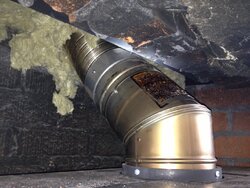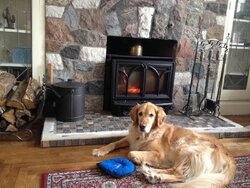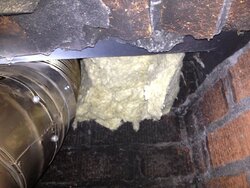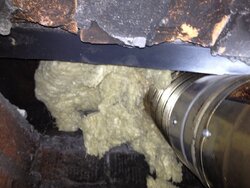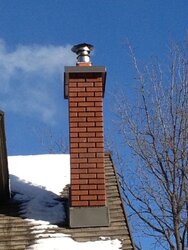So last week, we had a reputable (BBB highly rated) local fireplace shop install our new Jotul C450 insert, which we also bought there. A 'turn-key' install if you want to call it that. We had them come and do a consult, measure up our existing masonry fireplace, and give a price which also included putting in a new hearth, (2 layers micore, 2 layers durock, and I tiled with slate).
Chimey liner setup: They said they needed to order a special 45° elbow to clear my lintel and install the fireplace. It is being connected on one end to the stove, and the other it looks like they attached to the adapter (from the 6' uninsulated ss liner kit), then to the liner. Notice there is no block off plate. I mentioned this to them and they insisted that if they stuff the top and bottom with Roxul, there is no problem.
My observations: a) I hear an extremely annoying sucking noise when the fire gets up to temp and I suspected it is where the liner meets the adapter (which I confirmed by holding a match in this area). b) There is also a screw-hole where there is no screw and air sucks in there as well. c) before the label got burned unrecognizable, the arrow showing the direction of airflow was pointing down. I thought that these guys must know this and no big deal (maybe thats the case). d) the screws look like they are getting a much lighter color of grey, and I'm wondering if they used the SS screws.
My questions: a) Is this setup not done properly, the backwards elbow and air leaking issues make it appear to be an issue? I would have preferred them bring the liner down and connect direct to the stove, and it looks like it is possible. b) Will the elbow cause me problems down the road with cleaning, etc? c) Do I need to worry about dissimilar metal issues here and get the screws changed out? d) Lastly, the block-off plate... I am ok with the stuffing of Roxul up there as long as I don't have draft issues. There is no air leakage back through the chimney that I can detect.
Thanks for the help/advice on this. I really like the stove and it is working well, I just want to get it done right and now is my chance to do so (they come Monday to do the final trim kit and adjustments as well as collect another $2k)
Chimey liner setup: They said they needed to order a special 45° elbow to clear my lintel and install the fireplace. It is being connected on one end to the stove, and the other it looks like they attached to the adapter (from the 6' uninsulated ss liner kit), then to the liner. Notice there is no block off plate. I mentioned this to them and they insisted that if they stuff the top and bottom with Roxul, there is no problem.
My observations: a) I hear an extremely annoying sucking noise when the fire gets up to temp and I suspected it is where the liner meets the adapter (which I confirmed by holding a match in this area). b) There is also a screw-hole where there is no screw and air sucks in there as well. c) before the label got burned unrecognizable, the arrow showing the direction of airflow was pointing down. I thought that these guys must know this and no big deal (maybe thats the case). d) the screws look like they are getting a much lighter color of grey, and I'm wondering if they used the SS screws.
My questions: a) Is this setup not done properly, the backwards elbow and air leaking issues make it appear to be an issue? I would have preferred them bring the liner down and connect direct to the stove, and it looks like it is possible. b) Will the elbow cause me problems down the road with cleaning, etc? c) Do I need to worry about dissimilar metal issues here and get the screws changed out? d) Lastly, the block-off plate... I am ok with the stuffing of Roxul up there as long as I don't have draft issues. There is no air leakage back through the chimney that I can detect.
Thanks for the help/advice on this. I really like the stove and it is working well, I just want to get it done right and now is my chance to do so (they come Monday to do the final trim kit and adjustments as well as collect another $2k)


